The Pineal Gland – The Bridge to
Divine Consciousness (cont.)
Part 4: The Legends of Christmas and Santa Claus
Part 5: Jesus and the Sacred Mushroom |
Part 1: Overview, Glands and Chakras | Part 2: History, Kundalini and the All-Seeing Eye
| Part 3: The Sacred Mushroom, Enthogens and DMT
by Scott Mowry
AMANITA MUSCARIA and THE LEGEND OF CHRISTMAS
The correlation of the Amanita Muscaria mushroom to the story of Christmas and Santa Claus is a truly fascinating tale. The legend, or more accurately, the myth of Christmas, began very differently from what we have come to believe in today.
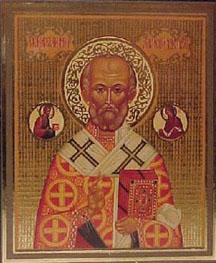 Saint Nicholas (270-346 AD), it was said, was a real person and widely recognized as an actual Christian saint. He has origins in Greece around the third century AD. Saint Nicholas, Saint Nicholas (270-346 AD), it was said, was a real person and widely recognized as an actual Christian saint. He has origins in Greece around the third century AD. Saint Nicholas,
(pictured left), became well known as the patron saint of sailors, and most especially, of children. His popularity became widespread throughout Russia, and, most particularly, Siberia.
It is purported that Saint Nicholas was perscecuted for his Christian faith by the brutal Roman Emporer Diocletian (284-305 AD). Yet, perhaps, the story of his oppression may be more about supporting the Christian myth, than to historical accuracy, simply due to the fact that this appears to be a common thread. Wherein there have been numerous distortions and outright falsehoods centered around the legend of Christmas.
Somewhere along the way, Saint Nicholas morphed into Saint Nick, and eventually, so we are told, he became the origin of our modern day version of Santa Claus. Again, this blantanly appears to be more Christian myth, than reality.
However, when you add in the birth of the Jesus Christ into the mix, then religion drastically blurs the facts to support the Christian dogma, as put forth most notably by the Catholic Church. Christian mythology tells us that the holiday of Christmas is to commerate the alledged birth of Christ on Decmber 25th. Yet many alternative scholars have pinpointed his actual birth at around August 8th.
The Christian version of the birth of Jesus; ie, born of a virgin, in a manger, attended by three wise men, etc., is one that is often repeated throughout history, and may actually be based upon paganism and the astrological movement of the planets, Sun and stars. The film, "Zeitgeist" offers futher perspectives on the astonishing similiarites of the life of Jesus, to that of other significant religious figures, such as Horus, Krishna, Dionysus, Mithra and others.
However, in parts of eastern Siberia, a much different tradition was honored at this momentous time of year we have come to know as Christmas. In these ancient villages, the tribal shaman or medicine man, would be the one to co-ordinate a celebration that was meant to mark an act of expanding consciousness.
During those times, it was a tradition for the shaman to venture out into the forest in search 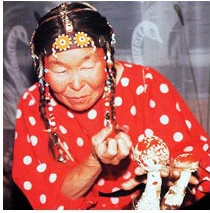 of the Amanita Muscaria mushrooms, which were found growing primarily under pine or evergreen trees. The shaman would collect the mushrooms into a sack or satchel for all the people of his village, as part of this celebration. In keeping with the ritual, the shaman would be dressed in a red and white clothing, (pictured right), sometimes with white fur around the collar, to symbolize the colors of the Amanita Muscaria mushroom. of the Amanita Muscaria mushrooms, which were found growing primarily under pine or evergreen trees. The shaman would collect the mushrooms into a sack or satchel for all the people of his village, as part of this celebration. In keeping with the ritual, the shaman would be dressed in a red and white clothing, (pictured right), sometimes with white fur around the collar, to symbolize the colors of the Amanita Muscaria mushroom.
The people of his village all lived in yurts, which were tent-like structures covered with reindeer skins. In the winter time, the main entrance to the yurts would often become buried in deep, heavy snow. So, out of necessity, the shaman would have to enter the home through the secondary entrance, which would be found at the top of the roof or the smoke hole, which would be considered to be the chimney in a modern home.
The shaman entering through the chimney was seen as both a symbolic, as well as, a necessary gesture, as he came bearing his gifts of the sacred Amanita Muscaria mushrooms, as if descending down from the heavens. Hence the legend of Santa Claus entering the home by way of the chimney.
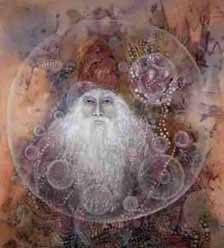 Once the shaman delivered his "presents" to his villagers, the mushrooms would then be hung to dry above the home fires or the fireplace, suspended from strings or stockings. The shaman himself, may have even have placed them on the pine trees to dry in the sun, as he gathered them in the forest. Thus, our tradition of hanging stockings by the fireplace and placing brightly colored ornaments on the green Christmas tree. Once the shaman delivered his "presents" to his villagers, the mushrooms would then be hung to dry above the home fires or the fireplace, suspended from strings or stockings. The shaman himself, may have even have placed them on the pine trees to dry in the sun, as he gathered them in the forest. Thus, our tradition of hanging stockings by the fireplace and placing brightly colored ornaments on the green Christmas tree.
The mushroom itself, (pictured below), could be seen as a symbol for the shaman (pictured above), or Santa 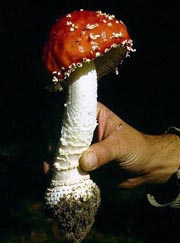 Claus, with its red and white cap (Santa's hat), the long white stem with the hanging skirt (Santa's beard) and the soiled black roots (Santa's black boots). Claus, with its red and white cap (Santa's hat), the long white stem with the hanging skirt (Santa's beard) and the soiled black roots (Santa's black boots).
To add even more irony to the story, it turns out that caribou, or reindeer, are also fond of eating the Amanita Muscaria mushrooms and just as humans, they too experience a psychedelic euphoria and may wander about high on a psychedelic experience of their own. Therefore, this is where the legend of Santa and his "flying" reindeer that pull his sleigh across the night sky on Christmas Eve comes into play.
So in essence, Christmas, at is 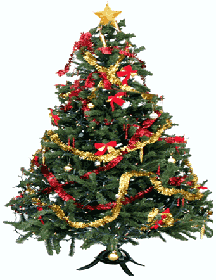 very incepetion, actually represents a celebration of expanding consciousness, as symbolized by the green pine tree/Christmas tree, aka, the pine cone, aka, the pineal gland. The pine tree also serves as symbology for the "Tree of Life"or the "World Tree", while the lights or garlands we wrap around it represent the kundalini energy rising up the chakra ladder, or, the tree found within the human body. very incepetion, actually represents a celebration of expanding consciousness, as symbolized by the green pine tree/Christmas tree, aka, the pine cone, aka, the pineal gland. The pine tree also serves as symbology for the "Tree of Life"or the "World Tree", while the lights or garlands we wrap around it represent the kundalini energy rising up the chakra ladder, or, the tree found within the human body.
While the colors of red and white would symbolize the shaman, (aka Santa Claus), or the gifts found under the tree, or in other words, the Amanita Muscaria mushroom that are found growing under the pine or evergreen tree.
In fact, it used to be traditional for the red and white mushroom to often be depicted in antique Christmas imagery (pictured below), such as cards, ornaments, elves, fairies, etc.
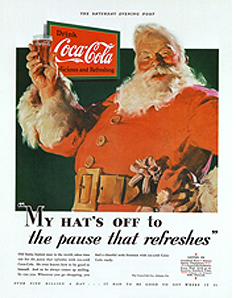 While the modern day image of Santa Claus (pictured left) that we have come to accept in this country, essentially was spawned in the marketing department of the Coca-Cola company in the 1930's, as a ploy to sell more Coke to children. And as was noted earlier, soft drinks, such as Coca-Cola, are some of the main inhibitors in the healthy function of the pineal gland. While the modern day image of Santa Claus (pictured left) that we have come to accept in this country, essentially was spawned in the marketing department of the Coca-Cola company in the 1930's, as a ploy to sell more Coke to children. And as was noted earlier, soft drinks, such as Coca-Cola, are some of the main inhibitors in the healthy function of the pineal gland.
Coincidence? You decide.
So thus, the legend of Santa Claus, which was once strongly associated with a celebration of expanding consciousness in the pineal gland though the sacred mushroom and DMT, was rechristend by a soft drink company, whose ingredients are known to contribute to the calcification of said pineal gland.
Regardless, it is undeniable that the celebration of Christmas has lost much of its spiritual, and even to some extent its religious importance and has become completely overshadowed by its commercial significance. Once again, another common thread that now runs through all holidays such as Easter, Halloween, Valentine's Day and even, to a lesser degree, our own birthdays.
The commercialization of religious holidays can be traced back to the implementation of the Gregorian calendar, which significantly altered the concept of time as was practised and followed by indigenous peoples around the world.
Particularly, the Mayan calendar, which were destroyed on orders by the Spanish King, who just happened to be the head of the Holy Roman Empire.
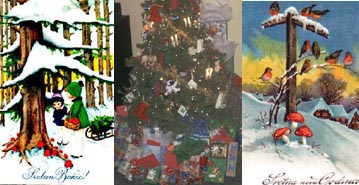
[ top of page ]
continued in Part 5: Jesus and the Sacred Mushroom
Part 5: Jesus and the Sacred Mushroom |
Part 1: Overview, Glands and Chakras | Part 2: History, Kundalini and the All-Seeing Eye
| Part 3: The Sacred Mushroom, Enthogens and DMT

Tools for Transformations
Ho'oponopono | The Oneness Blessing | EFT | Attracting Wealth |
Molding Clay: The Power of Focus | Enhanced Relationships | Matrix Energetics |
The Law of Attraction | Health and Wellness | Heroes of Enlightenment | 2012 |
The Pineal Gland | The Solfeggio Frequencies | The Love Intention |
Rating Human Consciousness | Extra-Terrestrial Disclosure | David Wilcock |
José Argüelles | Edgar Cayce | Gregg Braden | David Hawkins Scale |
Dolores Cannon | Carl Johan Calleman | Robert Monroe |